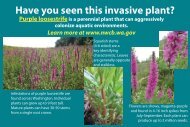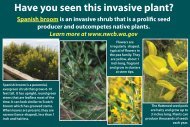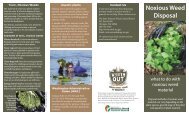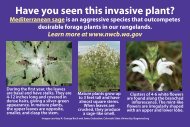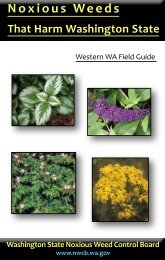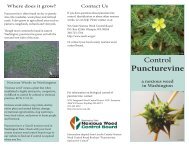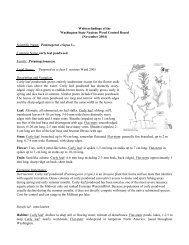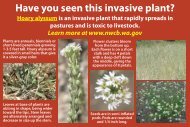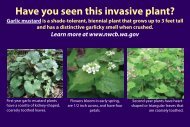May - Washington State Noxious Weed Control Board
May - Washington State Noxious Weed Control Board
May - Washington State Noxious Weed Control Board
Create successful ePaper yourself
Turn your PDF publications into a flip-book with our unique Google optimized e-Paper software.
presented at many of the spring CWMA meetings. They were preparing for end-of-fiscal year,<br />
preparing publications and outreach campaign.<br />
MARKETING CAMPAIGN UPDATE<br />
The <strong>Board</strong> reviewed three logos. Wendy provided an update about the <strong>State</strong> <strong>Weed</strong> <strong>Board</strong>’s<br />
outreach campaign.<br />
The goal of the outreach campaign was to create a clear, positive, empowering message for the<br />
residents of <strong>Washington</strong> that would give them an action they could take.<br />
The marketing agency Drake Cooper had developed the main logo “<strong>Weed</strong> ‘Em Out: <strong>Noxious</strong><br />
<strong>Weed</strong>s Damage Our Resources”. The goal was to develop a primary message that encouraged<br />
people to remove (‘how’) noxious weeds (‘what’) because they damage our resources (‘why’).<br />
The word ‘our’ was chosen to make the slogan inclusive, and the word ‘resources’ was meant to<br />
be vague to include all types of economic, agricultural, and ecological resources.<br />
The <strong>Board</strong> also received an additional pair of logos with the message “<strong>Weed</strong> ‘em and Reap’.<br />
While the first logo focused on basic awareness, the second slogan went a step further by<br />
reminding people that by removing noxious weeds, one would reap (sometimes literally) the<br />
benefits. One logo focused on natural resources and the other focused on agriculture.<br />
WSDA UPDATE<br />
Greg Haubrich provided the update.<br />
Bridget Simon was working part-time working for WSDA again and just completed the Yakima<br />
River CWMA plan.<br />
RFP for knotweed control was distributed and the closing date was the end of <strong>May</strong>. The<br />
knotweed program moved from general fund to ALEA so projects could now run up to the end of<br />
the fiscal biennium instead of every fiscal year.<br />
Spartina monitoring and eradication would be starting soon.<br />
There was less FHP funding available this year. It had been $310K but was now only expected to<br />
be $142.5K next funding cycle.<br />
The <strong>Board</strong> discussed:<br />
Steven Link had stepped down after providing six years of service as a scientific advisor. Alison<br />
is working with Greg to find a suitable replacement for that position.<br />
Tim Miller was on sabbatical through October and Dave Heimer from WDFW had agreed to<br />
serve as interim chair of the <strong>Noxious</strong> <strong>Weed</strong> Committee.<br />
FINANCIAL REPORT<br />
The <strong>Board</strong> reviewed the budget summary for April. Alison explained that she had been working<br />
on projected expenditures for <strong>May</strong> and June to estimate end-of-year budget. Sarah and Tony had<br />
looked at these projections at their North Bend meeting. There would be at least a $1,200 buffer,<br />
based on estimated purchases and costs through June.<br />
Sarah asked whether unspent funds could be used to purchase herbicides or other items. Alison<br />
noted that they had purchased herbicide in the past such as Milestone to help with small Class A<br />
eradication projects.<br />
REVIEW OF REVISED CODE OF ETHICS POLICY<br />
At the March meeting, Butch had asked Tony, Sarah, and Alison to work on a revised<br />
WSNWCB code of ethics (COE). They met in North Bend in early <strong>May</strong> to draft up a new set of



